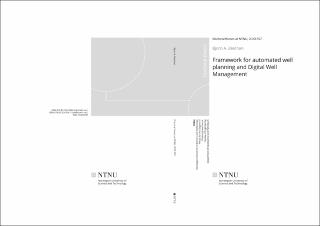| dc.description.abstract | This research was initiated to establish mitigations of the performance gap in well construction. Expert representatives from each discipline spend on average 4,000 to 6,000 manhours of planning for each offshore well, resulting in 15 to 20% non-productive time. The largest source of saving, however, was identified in field trials using “Drilling performance analytics” software and automated rig equipment. Significant invisible lost time is concealed in the time reported as effective operations. With more than 20 years’ experience from onshore and offshore drilling, completion and intervention engineering and supervisor roles, the industry practices and procedures were scrutinized to find the best fundament for a new sustainable way of working.
The work processes for planning and support of well construction and intervention is human based. I.e. engineers of different disciplines manually select input, feed software models and analyze the result before processing further to other linked models. The main product from this work is a groundbreaking new work process tying all disciplines together in a digital and automated process. An application is designed to link equipment properties, experience, engineering, etc., and produce digital programs and procedures. The application is called Well Operative System (WOS). Several other actors in the market are developing applications performing automated engineering. The WOS, however, is currently the only application designed to provide automated support for administrative tasks and to establish digital programs and procedures. Engineering comprises ~15% of the workload and administration is minimum 70%. I.e. the WOS will free up significantly more manhours and provide programs and procedures of the highest quality because no other application is designed to apply experience and best practices as fundament when deriving methods and operational parameters for programs and detailed procedures. The estimated total saving using the WOS with modern engineering modules is between 20 to 30% of current well cost using smarter and leaner methods and designs.
The framework of the WOS is presented, but the development method for the software is not elaborated. Most of the engineering models exist in prototypes and some of the prototype engineering applications are covered in 6 of the 13 papers produced. The focus in this thesis is the new, fully automated and digital workflow for planning. The WOS has 2 loops, where the first produces a framework for the digital program and the second perform iterations that tune and optimize operational parameters. WOS loop 1 is programmed, but loop 2 is prepared only with few checks of functions. The first prototype of the WOS is therefore about 20% complete.
A key enabler for the dynamic abilities and fully digital platform is a universal language describing all tools, activities, services and processes. The given name is “report language” since it builds on codes and reporting format used in daily rig activity worldwide. Operators use reporting systems typically designed to describe all events and measure time consumption for efficiency. This research developed the reporting system further by adding some features to enhance the codes and connected engineering, logistics, contracts, etc. The format of the report language represents a familiar interface to industry professionals who can use the WOS with minimal training. Requiring no programming ability, the WOS is designed with a fully dynamic planning platform where the user is in complete control. Digital experience is designed to use the report language and has the same format as programs. Their appearance may be thought of as miniature procedures that are readable for man and applied by the WOS in planning. It can be used to give any property to any formation, equipment or describe methods as sequences of desired operational steps.
Once operational, the application for fully automated activity planning and support can be a game changer providing safer and more cost-effective operations for rigs with and without automated equipment. Further development of the WOS needs support and funding of resources. | en_US |
